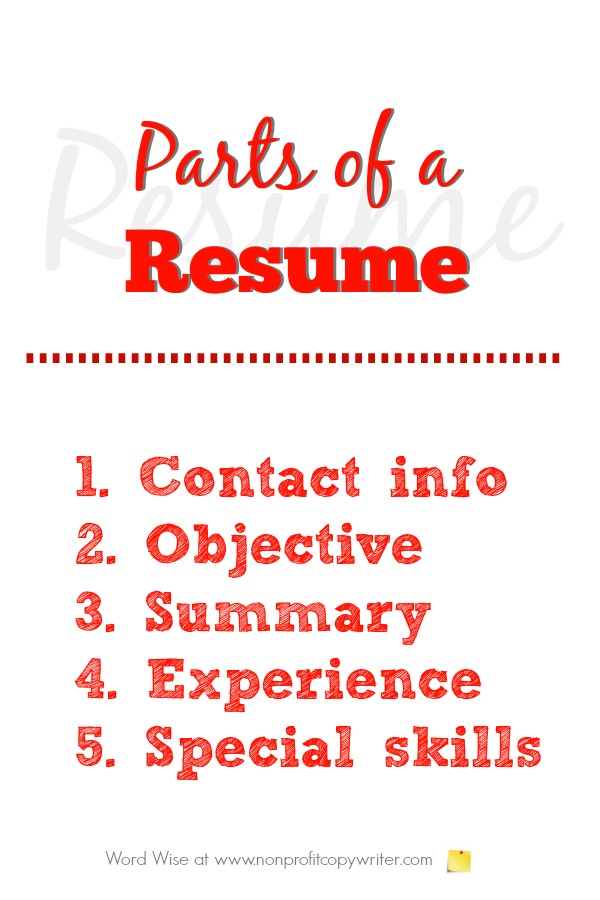Save Time: Get 5 Simple Writing Tips
you can put to use in 10 minutes
Parts of a Resume: A Primer
Award-winning writer Kathy Widenhouse has helped hundreds of nonprofits and writers produce successful content , with 750K+ views for her writing tutorials. She is the author of 9 books. See more of Kathy’s content here.
The basic parts of a resume outlined here are a tool you can use to understand how resumes are constructed. This list will also help you gather your personal data, organize it, and present it effectively in a professional resume.
Every resume is unique … because each person and his experiences are unique. As such, there is no magic formula to presenting your information.
Having said that, most resumes incorporate the standard components listed here. Which ones you use and how you use them depend on a number of factors, such as the resume format you choose (chronological, functional, or blended), your employment history (new to the job market, career changer, or one with considerable experience), and your focus (an emphasis on a particular skill set, for instance.)
On a resume, each element is usually listed as a separate section (apart from the contact information, which serves as the document title.) The parts of a resume can be renamed to fit your situation using different terms listed below.
The parts of a resume
1. Contact information
Place this information as the header of your document. Include your complete name, address, telephone number, cell number, e-mail address and website (if you have one). Other personal details are not necessary. The contact information allows a prospective employer to get in touch with you.
2. Objective
Also called"Job Target" or "Employment Objective"
Your objective is a brief phrase or statement that summarizes the kind of position you’re seeking. (Here are tips for writing a resume objective.) You may list multiple closely related positions together, such as “Executive Secretary/Executive Assistant.” Recent college graduates and career-changers can indicate their search for “an entry-level position” in an appropriate field. If you’re pursuing more than one kind of job title, construct a separate job target/objective statement for each resume you build.
3. Summary
Also called "Qualifications" or "Qualifications Summary"
This thumbnail sketch should showcase your most marketable skills and abilities with concise, bold statements. Communicate your key strengths, assets and character traits – intangibles -- and back them up with supporting evidence. Write this section last, after you’ve organized your resume content and can extract your strongest qualities. Use positive, pro-active, results-oriented language.
4. Experience
Also called "Employment History" or "Work Experience"
This section gives a potential employer a detailed look at what you’ve accomplished. You can include any experience that is relevant to the position you’re seeking, paid or not. Volunteer work, internships, and self-employment can prove that you have the necessary skills to perform the job you’re applying for. (This resume worksheet can help you organize the information.)
5. Special Skills
Also called "Honors," "Special Skills and Activities," "Publications," "Credentials," or any variation, depending on the content
This is the place to put important or interesting information that does not fit anywhere else. List honors, awards, professional affiliations, security clearance ratings, and special skills, such as your ability to speak a foreign language, fluency in computer programs, or musical skills. Make note of any published works. If you’re a college student or new to the job market, list extra-curricular activities, including leadership roles you’ve held.
Get Your Reusable Resume Builder here.
What you don't need to list on your resume
References
Most employers expect you to provide references, so you needn’t necessarily state that you have them. However, if you choose to include a “References available upon request” statement at the end of your resume, never list the references themselves on the document.
Instead, create a separate sheet titled “References” that
includes your name, your contact information, each reference, your relationship with the reference, and the
reference's contact information. Have copies of your reference sheet available to hand an employer during an interview or to send in an email when requested.
Personal information
You do not need to include information about your family, marital status, gender, race, or religion on your resume.
More on writing resumes
Build your resume with a Reusable Resume Worksheet Builder ...
Basics about writing resumes: Frequently Asked Questions ...
3 main resume writing formats ...
Quiz: which resume writing format should you use?
Resume Writing Guide for Verbs: How-tos for words of action ...
Resume writing tips: easy do's and don'ts ...
Build a winning resume with a resume worksheet ...
Tips for writing resume objective ...
Writing a good cover letter: a step-by-step writing guide ...
Cover Letter Writing Tip: get the reader to take one step ...
Get more resume writing tips on our Writing Resumes Pinterest board...
Return from Parts of a Resume to Nonprofit Copywriter home
As an Amazon Associate I earn from qualifying purchases.
Share This Page

Named to 2022 Writer's Digest list
BEST GENRE/NICHE WRITING WEBSITE


Stop Wasting Time!
Grab your exclusive FREE guide, "5 Simple Writing Tips You Can Put to Use in 10 Minutes or Less"



THE PRO RESUME WRITER PROGRAM: The Ideal Spare-Time Writing Business!
Everything you need to start and run a successful spare-time resume preparation service. In only 6 hours and 35 minutes, you can be in business — well on your way to making upwards of $150 per hour.









